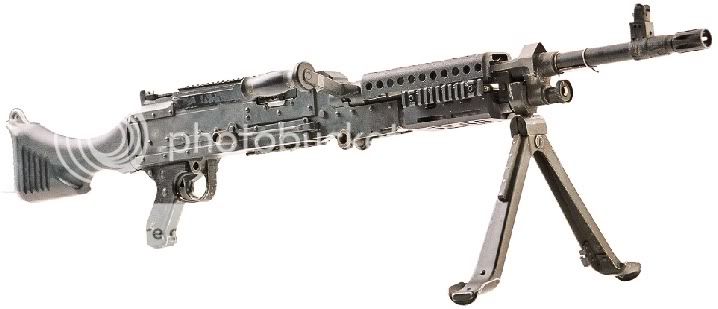
Weapon Name- M240
Type- Machine Gun
Damage- 3L
Range- 500/1000/2000
Ammunition- 500 per 27.5 lb
Strength Level- 4
Strength Level for firing- 4 for burst, 4 for medium burst, 4 for fully automatic
Special Consideration- Re-roll 8's. -1 to Initiative.
The weapon cannot technically jam or fail if it fails a reliability roll.
Like all machine guns, in order to reach the maximum range you need to fire in bursts.
Round Type- 7.62mm x 51mm NATO
Over-all length- 1,245 mm (49 in)
Barrel length- 627 mm (24.7 in) w/ flash hider
Weight- 12.5 kg (27.6 lb)
Rate of Fire- 650-950 rounds/min
Feed Mechanism- Belt Fed
Round Capacity- 50, 100, 150, 200, 250+
Accuracy- 2 MOA
Accessories- Picanty Rail
Quick switch firing mechanism- N/A
Scope/Sights- Picanty Rail
Muzzle Velocity- 840-905 m/s
Firing System- Gas-operated, open bolt
Miscellaneous/electronic information- Essentially a large and reliable tank machine gun capable of being be used on an individual basis.
Basic Information
Loading the weapon is performed by pulling the charging handle which locks the bolt to the rear. The weapon is placed on safe and the charging handle is pushed forward (this is spring loaded on the tank mounted version). The feed tray cover is then lifted and rounds are laid inside the feed tray. The feed tray cover is then closed and the weapon is ready for operation.
The weapon fires from the open bolt position meaning the bolt is held to the rear and only moves forward as it is firing a round. The firing pin is static and the bolt moves around the firing pin circumventing any need for a hammer. A sear is used to time the internal mechanisms of the weapon to provide a consistent rate of fire ensuring proper function and accuracy. However, firing from an open bolt also provides the possibility of accidental discharge due to a bolt override. This happens when there is enough force for the bolt to jump over the sear and fire without the trigger being pulled. The safety on the weapon cannot stop this from happening.
Clearing the weapon is performed by ensuring the bolt is locked to the rear and the weapon is on safe. The feed tray cover is then lifted, the remaining belt (if any) is swept out of the feed tray, the feed tray is lifted to visually inspect the rear of the barrel and the face of the bolt. Any links or brass casings are removed. The weapon is now clear. In the unlikely event that a live round is on the bolt face, it is knocked loose with a cleaning rod or another rigid object. If there is a live round lodged in the barrel, the operator must immediately decide if the barrel is hot enough that there is a chance of it cooking off. If there is, he will immediately move his face away from the opening of the weapon. He should then wait for the barrel to cool off before attempting to remove it. In many cases, attempting to remove the barrel will cause the round to detonate as soon as the barrel is unlocked from the receiver. He can also attempt to extract the round by taking the weapon off of safe, pulling the trigger and pulling back on the charging handle. This has a fair chance of causing the weapon to fire, so care should be made in ensuring that the weapon is pointed in a safe direction first.
M240D machine gun is fired from a SH-60F Sea Hawk.
The rate of fire may be controlled by three different settings. The first setting allows the weapon to cycle at 750 round/min. The two remaining settings increase the rate of fire by 100 round/min per setting (the second setting being 850 round/min, and the third setting 950 round/min). These settings are changed by dismounting the barrel, removing the gas regulator collar and turning the gas regulator to allow more or less gas to move through the weapon system. It is generally performed before missions, as changing the setting is distracting at best under field or combat conditions.
The barrels can be exchanged rapidly, thanks to a barrel release button located on the left side of the weapon. The weapon is cleared first and then the button is held down, while the barrel's carrying handle is moved from the right side of the weapon to the center, unlocking it from the receiver. At this point, the button is released and the barrel is then pulled free of the receiver and placed to the side. The new barrel is inserted into the receiver and then the carrying handle is shifted to the right, locking it into place.
During prolonged firing, care must be taken to not allow exposed skin to come in contact with the weapon. The barrels can become hot enough to inflict second degree burns instantly without becoming visibly different. However, such barrels glow brightly to anyone using any sort of optics sensitive to infrared radiation, such as night vision devices.


